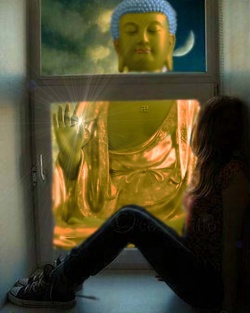Difference between revisions of "Harivarman's Satyasiddhi-sastra"
(Created page with " <poem> By {{Wiki|Johannes Rahder}} Philosophy East & West V. 5 (January 1956) p.348 This Indian Buddhist philosophical treatise of the first half ...") |
|||
| (One intermediate revision by the same user not shown) | |||
| Line 1: | Line 1: | ||
| − | + | [[File:1fgG.JPG|thumb|250px|]] | |
<poem> | <poem> | ||
By {{Wiki|Johannes Rahder}} | By {{Wiki|Johannes Rahder}} | ||
| Line 11: | Line 11: | ||
[[Takakusu]] (The [[Essentials]] of [[Buddhist Philosophy]], pp.74-79), following the {{Wiki|Chinese}} learned [[monks]] [[Chi-tsang]] (549-623) and [[Tao-hsuan]] (596-667), classified [[Harivarman's]] work as [[Hinayanistic]], but [[Sakaino Koyo]], author of a 2-volume history of [[Chinese Buddhism]] ([[Tokyo]], 1927), has pointed out its predominantly [[Mahayanistic]] features in an article contributed to the anniversary volume for the late expert on [[Chinese Buddhism]], [[Tokiwa Daijo]] ([[Tokyo]], 1933). | [[Takakusu]] (The [[Essentials]] of [[Buddhist Philosophy]], pp.74-79), following the {{Wiki|Chinese}} learned [[monks]] [[Chi-tsang]] (549-623) and [[Tao-hsuan]] (596-667), classified [[Harivarman's]] work as [[Hinayanistic]], but [[Sakaino Koyo]], author of a 2-volume history of [[Chinese Buddhism]] ([[Tokyo]], 1927), has pointed out its predominantly [[Mahayanistic]] features in an article contributed to the anniversary volume for the late expert on [[Chinese Buddhism]], [[Tokiwa Daijo]] ([[Tokyo]], 1933). | ||
| − | The earlier {{Wiki|Chinese}} [[monks]], like [[Chih-tsang]] (458-522), [[Seng-jou]], and [[Hui-Tz'u]], minimized the difference between [[Nagarjuna's]] | + | The earlier {{Wiki|Chinese}} [[monks]], like [[Chih-tsang]] (458-522), [[Seng-jou]], and [[Hui-Tz'u]], minimized the difference between [[Nagarjuna's]] [[Mahayana]] and [[Harivarman's]] [[doctrines]] of the [[Middle Way]], {{Wiki|nominalism}} (a [[development]] of the [[Praj~naptivada]] and [[Sautrantika schools]]), [[upaya]], the pre-eminence of the [[truth]] of {{Wiki|annihilation}} among the [[Four Noble Truths]], and relativistic [[dialectics]]. The founder of the {{Wiki|Chinese}} [[San Lun]] [[sect]] has been strongly influenced by his study of [[Harivarman]]. |
| − | This founder is [[Seng-lang]], who came from [[Korea]] to [[China]] between 494 and 497. N. Aiyaswaami ` | + | This founder is [[Seng-lang]], who came from [[Korea]] to [[China]] between 494 and 497. [[N. Aiyaswaami `[[Sastri Santiniketan]]) is preparing a translation of the [[Satyasiddhi-sastra]]. He points out in his article on "[[Nagarjuna]] and [[Satkaryavada]] of the [[Sankhyas]]" (Sino-Indian Studies, Vol. 4, pp.47-50) that the [[Satyasiddhi-sastra]] rejects the {{Wiki|theory}} that the effect [[exists]] in a potential [[state]] in its [[cause]]. He refers to the [[Satyasiddhi-sastra]] in notes of his recent translation of [[Nagarjuna's]] [[Dvada`samukha-sastra]], [[Visvabharati]] Annals, Vol. 6, pp.165-231 ({{Wiki|Santiniketan}}, 1954). |
</poem> | </poem> | ||
{{R}} | {{R}} | ||
[http://buddhism.lib.ntu.edu.tw/FULLTEXT/JR-PHIL/ew27145.htm buddhism.lib.ntu.edu.tw] | [http://buddhism.lib.ntu.edu.tw/FULLTEXT/JR-PHIL/ew27145.htm buddhism.lib.ntu.edu.tw] | ||
| − | [[Category:]] | + | [[Category:Buddhist Philosophy]] |
| + | [[Category:India]] | ||
Latest revision as of 07:33, 28 January 2015
By Johannes Rahder
Philosophy East & West
V. 5 (January 1956)
p.348
This Indian Buddhist philosophical treatise of the first half of the 4th century has come to us only in the Chinese translation of Kumarajiva (Taisho Daizokyo, Taisho Chinese Buddhist Canon, Tokyo, 1926, Vol. 32, pp.239-373; Nanjio No. 1274 成實論 Ch'eng Shih Lun). Its study may contribute to a more satisfactory definition of the terms Hiinayaana and Mahaayaana in the field of metaphysics, epistemology, and logic.
Takakusu (The Essentials of Buddhist Philosophy, pp.74-79), following the Chinese learned monks Chi-tsang (549-623) and Tao-hsuan (596-667), classified Harivarman's work as Hinayanistic, but Sakaino Koyo, author of a 2-volume history of Chinese Buddhism (Tokyo, 1927), has pointed out its predominantly Mahayanistic features in an article contributed to the anniversary volume for the late expert on Chinese Buddhism, Tokiwa Daijo (Tokyo, 1933).
The earlier Chinese monks, like Chih-tsang (458-522), Seng-jou, and Hui-Tz'u, minimized the difference between Nagarjuna's Mahayana and Harivarman's doctrines of the Middle Way, nominalism (a development of the Praj~naptivada and Sautrantika schools), upaya, the pre-eminence of the truth of annihilation among the Four Noble Truths, and relativistic dialectics. The founder of the Chinese San Lun sect has been strongly influenced by his study of Harivarman.
This founder is Seng-lang, who came from Korea to China between 494 and 497. [[N. Aiyaswaami `Sastri Santiniketan) is preparing a translation of the Satyasiddhi-sastra. He points out in his article on "Nagarjuna and Satkaryavada of the Sankhyas" (Sino-Indian Studies, Vol. 4, pp.47-50) that the Satyasiddhi-sastra rejects the theory that the effect exists in a potential state in its cause. He refers to the Satyasiddhi-sastra in notes of his recent translation of Nagarjuna's Dvada`samukha-sastra, Visvabharati Annals, Vol. 6, pp.165-231 (Santiniketan, 1954).
